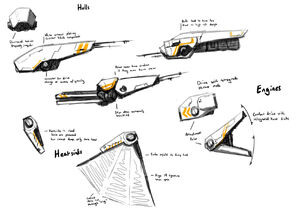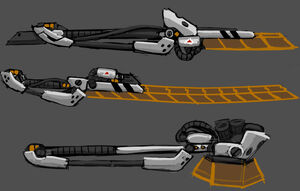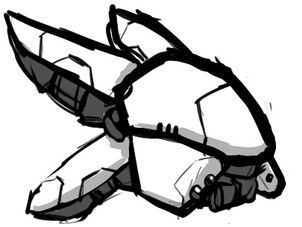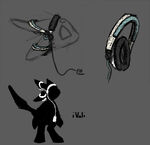Sitting on the cusp of technological singularity, Illuminate citizens are well known for their deep integration of cybernetic, virtual and augmentated reality technologies, with major portions of their society and infrastructure existing as a virtual world - the Nexus; parallel to the physical one. Nonetheless the scope of their technology is not beyond the familiar, even if it is highly refined in it's application and efficacy.
Vehicle design

To this end aerospace and deep space craft tend to have gimbaled drives and variable geometry chassis to maximize mobility, while ground vehicles often possess jump-jets, or are hovering vehicles. Dedicated combat units especially are often entirely autonomous allowing for even greater reaction speeds and acceleration without the limits imposed by organic crew and encumbrance of life support systems.
Most vehicles interface directly with the pilot's neural augmentation, allowing them to "see" through the vehicles external sensors and control the vehicle's geometry and movements as if it were part of their own body, giving them uncanny agility; whispered tales exist of truly skilled Avali pilots performing acrobatics in combat mechs or conducting parkour up the side of buildings when pressed to action.
Drones

The concept of a "drone" becomes a little hazy in Avali parlance. Almost all vehicles are capable of being piloted by remote; while a vehicle with a person in it is not necessarily being driven by it's occupant. Many drones possess simple AI which can handle tasks autonomously, though many more are remotely piloted by an operator.
Typically when an Avali refers to a drone, it means those craft that are incapable of carrying a passenger or crew, even though such "drones" can range between tiny protocol drones mere inches across, to 100ft long dedicated space combat vessels.
In this regard, drones are ubiquitous throughout their territory, visible everywhere you look carrying out all manner of daily tasks both autonomously and those remotely controlled by an operator through their neural interface; servitor drones helping manage daily life, medical drones providing care where it's needed in a civilian setting, to industrial drones helping build and maintain equipment, move cargo; and of course the somewhat more widely known (although in truth, far rarer), combat drones that provide security or serve as the front line in warzones.
Weaponry

Top of the line Avali aerotech vibroblades.
Avali weaponry is quite diverse, but due to a lack of oxygen and low temperatures of their homeworld (and thus dificult combustion), they have had a lot of reason to perfect electrical-based launchers such as railguns and gauss weaponry.
Standard infantry armament tends to be in the form of variable-setting gauss weapons, allowing the operator to toggle the rate of fire and capacitor discharge rate to suit their needs (from low power, high rate of fire suppression modes, to over-charged kill shots for snipers), as well as accepting a huge range of sub-munitions; self guided projectiles, smart grenades and gyrojets to shotgun-like flechette bundles, popular among civilians on outlying colonies for dealing with dangerous fauna.
While the military shies away from melee weaponry with good reason, some hunter tribes as well as many private citizens have a certain affinity for traditional weapons. Most of these melee enthusiasts utilize high frequency oscillating weapons (which the Avali call 'singing' blades, as they can typically perceive the high frequency sounds generated) which can slice through a target like a chainsaw.
While heavy, metal blades are commonly used by dedicated specialists for the extra heft. Ultra-light, flash-forged crystalline blades(or aerotech vibroblades) are popular as fallback weapons, as the weapon can be reduced down to just a grip when not in use via ejecting the blade. The blades are razor sharp, but brittle and dull quickly - thusly, they are forged in segments, designed to break off so that new sections can be pushed out. Due to their brittleness, the blades can fragment mid-stroke, leaving lethal shards in the victim and causing internal bleeding.

Railguns are typically reserved for larger craft, mechs and combat drones due to their impressive recoil and bulk, where they provide devastating anti-material capabilities; though some soldiers and hunters train to use railguns from on foot and serve as anti-vehicle specialists, or for taking down titanic prey. Spacecraft mount a range of railgun sizes too, smaller versions as anti-missile/fighter turrets, while colossal spinal railguns accelerate guided missiles which can continue to track, accelerate and resolve their aim as the shot closes in on it's target.
GRASERS are employed as the primary armament of larger Avali space combat vessels; a technology they guard jealously. Utilizing an anti-matter matrix to pump a gamma ray laser, these lance weapons are capable of striking a target at relativistic distances in space with little warning or chance of evasion. Even a hit that does not immediately compromise a target's hull is likely to transfer enough energy to spark internal fires and begin melting the underlying structure. GRASERS are ineffective in planetary atmospheres, so space to surface engagements usually rely on missiles or railguns.
Augmentation (Technical Standpoint)
For medical information about Avali augmentation, click here .
Virtually all Avali citizens have some degree of augmentation, even if only a neural jack and medical “Guardian” nanites.
The so-called "Guardian" nanites are the single most common augmentation, found in almost the entire population. They are a composed of several strains of small, self-replicating medical nanites that remain in the user's tissues and bloodstream, working to destroy pathogens, to detect and isolate disease, and to repair minor injuries or stabilize more major traumas, though they cannot directly heal an injury, or cure a disease this way; it will still require medical attention. The second most common augmentation is the environmental protection augment( or EPA), which works as a built in EPP. This allows an Avali to venture to "goldy locks" planets.
Neural augmentations are ubiquitous among the Avali and essentially for linking with the Nexus infrastructure. These consist of a small processor unit and a pair of physical connectors built into the base of the cranium, and thousands of tiny "wetware" filaments connecting to key parts of the brain. The unit itself also carries a small amount of internal memory which serves as a video buffer for it's augmented reality, audio and HUD functions. Naturally the system is hardened against intrusion, though there have been alleged incidents of the on-board memory being tampered with by hackers.
A significant number of Avali citizens, however, have also received significantly more invasive physical augmentations (though superior materials technology means it may be difficult to recognize them as such).
These augmentations often take the form of replacement limbs and organs, mostly fitted in response to debility or critical injury. Some, however, choose to be fitted with extensive cybernetic augmentations voluntarily, since the replacement limbs are both usually superior in function to the organic counterpart and less critical to survival in case of injury. Some even go so far as to receive full-body prosthetics, essentially reducing the individual to little more than a brain in an artificial casing riding a mechanized body.
Augments are not always one-for-one conversions of organic to mechanical parts. While the basic frame is typically standardized to match that of a fully-organic Avali, the internal workings of such parts may vary greatly, allowing for improved strength, concealed tools or devices, and potentially even radically different arcs of motion.
The Nexus
The Nexus is a powerful interstellar network of computers, systems, and information all enabled and networked through the use of the unique properties of the valuable sync crystals . The Nexus is accessed through neural jacks, augments installed in the brains of nearly all Avali citizens. Citizens use the Nexus nearly constantly, either through “augmented reality” (virtual projections upon the real world) or fully-fledged virtual reality simulations. Users represent themselves on the Nexus with a variety of avatars, which are not necessarily representative of their true identity.
Full-fledged browsing of the Nexus can be most closely compared to using the modern-day internet. Unlike seeing the internet as a series of pages, however, users of the Nexus experience sites on the Nexus as virtual locations. As a virtual landscape, however, the Nexus is not constrained by normal laws of transportation and motion. Illusions such as three-dimensional space and movement are just that in the Nexus: illusions. Users do not have to ‘walk’ between locations on the Nexus (though many sites may chose to represent motion as such for ease of use) and some of the more adaptable web locations on the Nexus would probably be set up so that information comes to the user when desired, rather than the user coming toward the information. Jumping between locations on the Nexus is really as simple as that; a user must merely choose another location to be whisked away.
Information gathering and processing is one of the most basic functionalities available through the Nexus, and one of the primary uses of augmented reality systems. The Nexus provides citizens with the ability to display information on objects, people, their environment, specific dates, complex mathematical formulae, and nearly anything else included in the Nexus’ unfathomably vast network. Not only can the Nexus display raw information, but it is also capable of projecting step-by-step directions and three-dimensional schematics imposed on the actual environment to users. This is incredibly useful to Avali trying to learn new and difficult tasks, or to specialists like architects and engineers.
Though Avali society is not extensively capitalistic, “marker” icons similar in concept to modern-day QR codes can work though the Nexus to project easily-modified advertisements and notices in real space.
Real-time chatting in virtual space is a simple proposition for the Nexus’ capabilities. Settings like online forums, in which participants may communicate while separated by space and time, are more complex. Managing such interactions, however, is crucial to the functioning of Avali society (Imagine trying to schedule a face-to-face virtual interview with someone on another planet, in another timezone, whose planet's day is two-thirds faster than your own). Simple chatting channels can be imagined as similar to a coffee bar or other pleasant recreational area designed to facilitate communication. Forums, however, must be regarded differently, as one of their main functions is the archival of communication. A forum would appear more like a size adaptive (the size of the meeting changes as new members enter a ‘thread’) meeting where users could leave audio-visual recordings of their messages. Others could join the conversation and participate in real-time while leaving a recording for those who come later, or merely watch the proceedings, or browse a text transcript if they prefer.
News sites work similarly to forums in terms of structure, but are organized less for informal discussion and more to allow users to quickly get tabs on recent events. This is usually paired with other functions of the Nexus, such as information provision and forums, to allow users to quickly research and learn about interesting topics and discuss them with others if they desire.
Virtual reality when combined with realistic simulation software is be a powerful tool for trade. While the Avali trade less and in significantly different ways then we do, they still need to distribute their surplus production. One way they can accomplish this is to utilize simulation technology to allow a customer to feel, try on, possibly even test-run virtual representations of equipment before buying the real item. Additionally, this system also ties in with augmented reality. A physical shop's window displays may very well be used as a holographic display of simulated products that use the Nexus' power to allow the customer to actually see and feel a completely virtual item.

The more casual approach to money and profit taken by most members of Avali society causes the vast majority of art, music, and entertainment to be produced for personal satisfaction and pleasure rather than for profit. This in turn has led to a vibrant environment for filesharing across the Nexus: avatars, music, specialized simulations; whatever can be made and distributed online. Files accessed through the Nexus are available both in virtual and augmented reality. An Avali using the Nexus can read a "book" on any blank background, or listen to music without using headphones. In the virtual world, such actions simply generate the book and headphones graphically as a cue to others.
Virtual reality easily accessed through the Nexus provides tremendous potential applications for gaming and simulation. However, most of such games would be designed to be easy to drop in and out of in order to facilitate use by players looking only for a quick distraction. Of course, "hardcore" games also exist, but they are largely outnumbered by smaller "softcore" games (just as modern games are outnumbered by cheap, simple, and fast mobile gaming apps).
Finally, the Avali can make use of the Nexus’s virtual reality capabilities for relaxation or for practicing their skills in a safe, customizable environment. Such simulations can be made as realistic as the author cares, and are an excellent place to meditate or practice hobbies. Interestingly, the nature of the simulation means that while an Avali used to practicing in simulations may know what to do to perform a task; his or her body may not actually be up to the challenge. As such, simulations generally use the most realistic avatars of all the Nexus' functions - avatars designed not just to look like their owner, but also to have their owner's physical limitations in order to prevent harm from an over-eager user trying something he "knows he can do" because he's "done it in a sim a million times."
Simulations are one of the most private of all the Nexus' functions, capable of high degrees of personalization. A user can scan in favorite objects (say a fragile antique lance that can't be used for hunting in the real world, a custom-built rifle, pieces of art, etc.), reconstruct favorite places or invent fictional environments, or just practice his shooting against a target in a blank white void as all his required equipment mysteriously slides out of the virtual floor.
Of course, this isn't Star Trek. It is also likely that pleasure sims form a strong but quiet portion of simulation culture.
SOMEBODY ADD SOMETHING ABOUT THE TECH AT HOME, PLEASE AND THANKYOU.